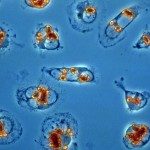Lien vers Pubmed [PMID] – 25959087
Proteomics 2015 May;
Protein phosphorylation is one of the most studied post-translational modifications that is involved in different cellular events in Leishmania. In this study, we performed a comparative phosphoproteomics analysis of potassium antimonyl tartrate (SbIII)-resistant and -susceptible lines of Leishmania braziliensis using a 2D-DIGE approach followed by MS. In order to investigate the differential phosphoprotein abundance associated with the drug-induced stress response and SbIII-resistance mechanisms, we compared nontreated and SbIII-treated samples of each line. Pair wise comparisons revealed a total of 116 spots that showed a statistically significant difference in phosphoprotein abundance, including 11 and 34 spots specifically correlated with drug treatment and resistance, respectively. We identified 48 different proteins distributed into seven biological process categories. The category “protein folding/chaperones and stress response” is mainly implicated in response to SbIII treatment, while the categories “antioxidant/detoxification,” “metabolic process,” “RNA/DNA processing,” and “protein biosynthesis” are modulated in the case of antimony resistance. Multiple sequence alignments were performed to validate the conservation of phosphorylated residues in nine proteins identified here. Western blot assays were carried out to validate the quantitative phosphoproteome analysis. The results revealed differential expression level of three phosphoproteins in the lines analyzed. This novel study allowed us to profile the L. braziliensis phosphoproteome, identifying several potential candidates for biochemical or signaling networks associated with antimony resistance phenotype in this parasite.

